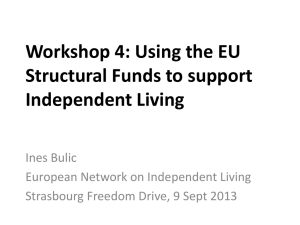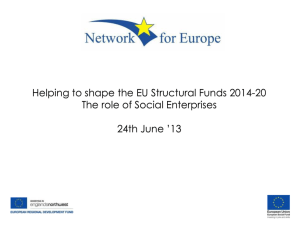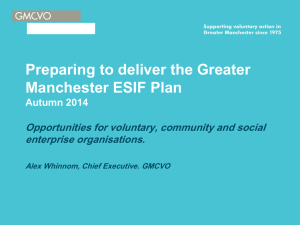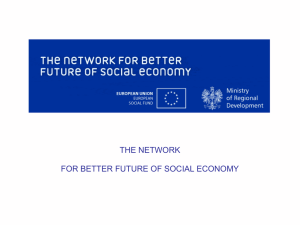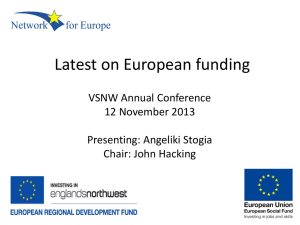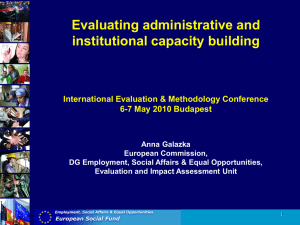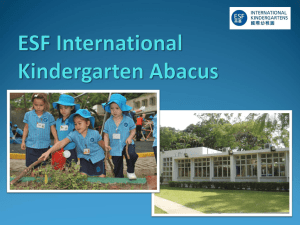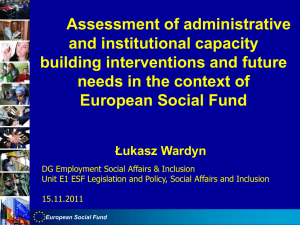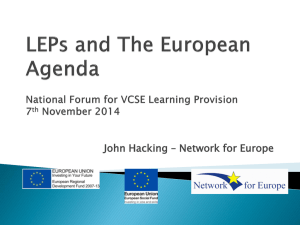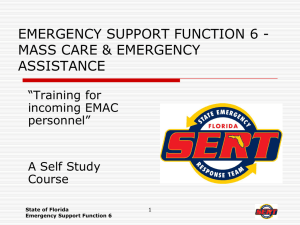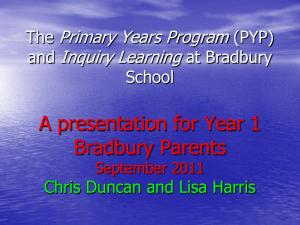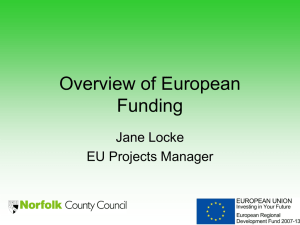Alan EU presentation
advertisement
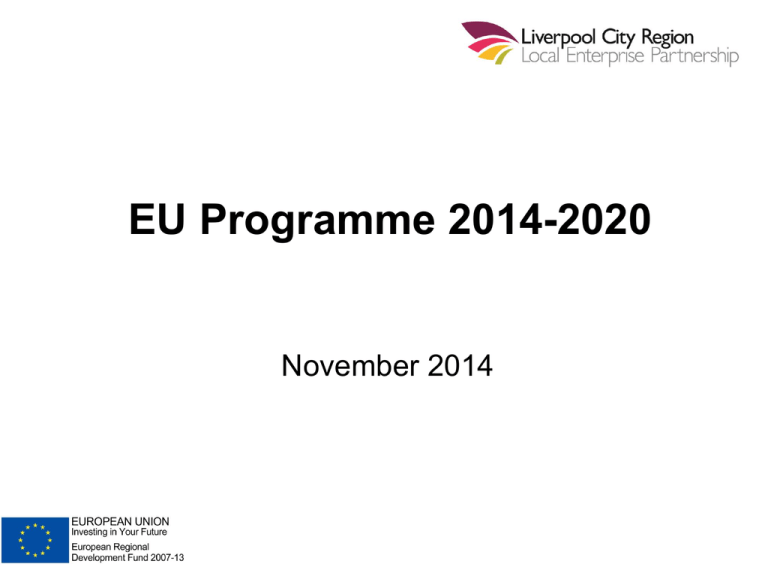
EU Programme 2014-2020 November 2014 EU Context • Current EU Programme 2007-2013 (projects can deliver until June 2015) • New EU Programme 2014-2020 • Thematic approach, concentrated on: Innovation, research, technology dev ) Competitiveness, SMEs ) ICT ) 60%+ ERDF Transition to Low Carbon Economy (15%) ) Employment and Skills Social inclusion (20% of ESF) Rural development • Intervention rate of 60% for transition regions • Closer links to Horizon 2020 envisaged UK Context • Govt asked LEPs to lead on EU Investment Strategy • LEP led programmes / activities to • focus on local need and opportunity • reflect and align with national policy and priorities • LEP and local partners working together (regulatory) • Local EU Strategies sit within the National Growth and Job strategy Single pot ( April 2015) • LEPs to produce a Local Growth Plan / Competitive element • Local Growth Teams to support and ensure compliance • Supplementary guidance (received July 2013) • Opt-in prospectuses (received July 2013) LCR Allocation • LCR given EU allocation of €220.9m (c. £190m) (£112.3m ERDF / £77.7m ESF) • Judicial Review ongoing • Roughly 1/3 of amount received in 2007-2013 period • Government methodology based on 2013 allocations • extended 2013 amount for a seven year period • Transition Regions given a 20% uplift • Penalises LCR “phasing in” status in the current period (because of front loading) • Equates to €147 per head of population (lowest in NW) and half that awarded to the North East • 6 “More Developed” regions will receive more than LCR What UK Government wants • Collective submissions from 39 LEPs and can come together to create a national ERDF and ESF programme • A strong emphasis on economic growth (to create jobs) • international trade (to help balance of trade) • low carbon / energy (sustainability and climate change agenda) • Greater involvement of the private sector • developing local strategy / priorities • programme delivery (particularly private sector match funding) • Opportunities for Govt Depts (BIS, DWP etc) to access ERDF and ESF by asking LEPs to “opt-in” to national initiatives • More investment and less grant • Increased use of revolving funds, • encouraging LEPS to use Financial Instruments • Continued focus on about claw back and misuse of EU funding • tight control of programme management and project approvals LCR Approach • A significantly different programme • Cut our cloth accordingly • Acts as a catalyst • Unlocks major schemes • Need for focus and fewer projects • Challenging but realistic in delivery terms • Remains a significant funding package • Moving towards a commissioning model What we have done so far... • Stakeholder events (April & September 2013) wider buy-in • Bottom up approach: • • • • • • • • • Initial Thematic responses led by Thematic leads Distilled into 5 Liverpool City Region Portfolios 5 Portfolio drafting workshops (July 2013) 5 Portfolio consultation workshops (August 2013) 5 Portfolio delivery workshops (December 2013) Leadership / challenge by EU Sub group and Advisory Group Draft ESIF submitted to Govt early October 2013 Final ESIF submitted to Govt end Jan 2014 ESIF now signed off by Govt Portfolio Approach • Blue/ Green Economy • Business Economy • Innovation Economy • Inclusive Economy • Place and Connectivity Portfolio Approach • Reflects LCR opportunities and challenges • Integrated and focused approach • Aligned to City Region governance • Guards against “unpicking” • Clear LCR narrative to Government and partners • Based on long established evidence base • Seamless fit into Local Growth Plan • Challenge to partners to avoid silos Indicative Budget (Portfolios) in £s Portfolio ERDF ESF Totals Blue Green 25m 3m 28m Business 32m 8m 40.8m Innovation 26.5m 5m 31.5m Inclusive 3m 61.7m 64.7m Place & Connectivity 25m - 25m Total 112.3m 77.7m 190m 10 Indicative Budget (Blue Green) in £s Blue / Green ERDF Energy 5m Supply chain 5m Infrastructure 5m Infrastructure (FIs) 10m Skills Total ESF Totals 3m 25m 3m 28m 11 Indicative Budget (Business) in £s Business ERDF Winning new business 7m Start up and entrepreneurship 8.8m Business support, investment readiness 7m Finance for business FI 10m Skills Total ESF Totals 8m 32m 8m 40.8m Indicative Budget (Innovation) in £s Innovation ERDF Infrastructure (grant) 5m Infrastructure FI 5m Business start and early growth 3.75m Finance for business FI 5m Business growth 6.5m Higher level skills Promotion of LCR Total ESF Totals 5m 1.25m 26.5m 5m 31.5m Mi Liverpool Liverpool Knowledge Quarter Marine Energy Deploymen t and Operations Centre Hydrogen Network Stratified Health Health and Wellbeing Advanced Manufacturing Solutions for sustainable growth Sci-Tech Daresbury Creative and Digital Materials Manufacturing Technology Innovation Centre Factory Liverpool Plug and Play Sensor City Big Data Innovation Exchange 14 Indicative Budget (Inclusive) in £s Inclusive ERDF ESF Youth and NEETS 30m Adults into work 20m Social growth and connectivity 10m Local Impact Fund FI Total 3m 3m 1.7m 61.7m Totals 64.7m Indicative Budget (Place and Connectivity) in £s Place and Connectivity ERDF ESF Totals Business infrastructure (gap funding) 6m Infrastructure FI 9m Transport Infrastructure 7.5m Place marketing 2.5m Total 25m 25m Outputs Output Enterprises supported Number 1,665 New jobs created 2,000 New companies established 600 Companies involved in research collaboration Amount private sector funding levered 110 Reduction of GHG emissions (Tonnes) 80,000 Number of ESF beneficiaries/ participants 56,000 ESF participants unemployed ESF participants inactive ESF participants employed ESF participants 15- 24 years old 39,000 11,000 6,000 28,000 £77m Financial Instruments Building on previous experience (North West Fund / MSIF / Chrysalis) • £24m infrastructure / energy (JESSICA) • Up to £15m financial assistance for businesses (JEREMIE) • £3m financial assistance for social enterprises / charities (Local Impact Fund) • Total FI Spend: £42 million • Evaluations of current JESSICA and JEREMIE programmes are underway • Local Impact Fund pilot project Opt-ins • Opt-in model to allow LEPs and partners to join with national organisations/programmes • LEPs commit part of funds to national programme • In return local areas receive match funding / administrative support Organisation/ Programme Support Amount DWP Employment £5m ESF tbc Big Lottery Fund Social inclusion & combating poverty £1m ESF tbc Skills Funding Agency Skills £24m ESF tbc Rural Programme • The Rural Development Programme will be overseen by the European Agricultural Fund for Rural Development (EAFRD) PMC. • The Liverpool City Region Rural Development Programme has been allocated £339,995 for the 2014-2020 period. • The Local LCR EU Sub-Committee will also have responsibility for EAFRD alongside ERDF/ESF. • The PMC for ERDF and ESF will advise the EAFRD PMC on any issues that may require modifications to the Rural Programme. Timeline UK Government • Feedback from Govt on all 39 ESIFs – April 2014 • Govt consult and negotiate draft Operational Programmes – Summer/Autumn 2014 • UK Partnership Agreement – signed off October 2014 • Expected programme start - early/mid 2015 Liverpool City Region • Develop Commissioning/Bidding Framework • Shadow ESIF Committee and EU Delivery Group established • Work with DCLG on business process / programme management • Publish the LCR ESIF and produce summary brochure
